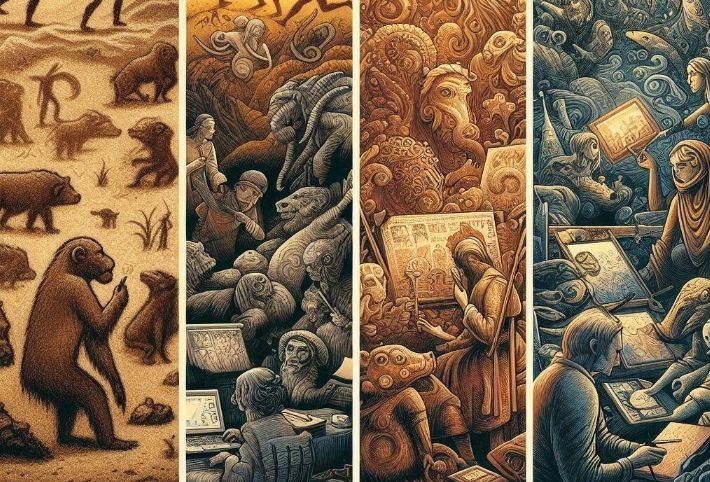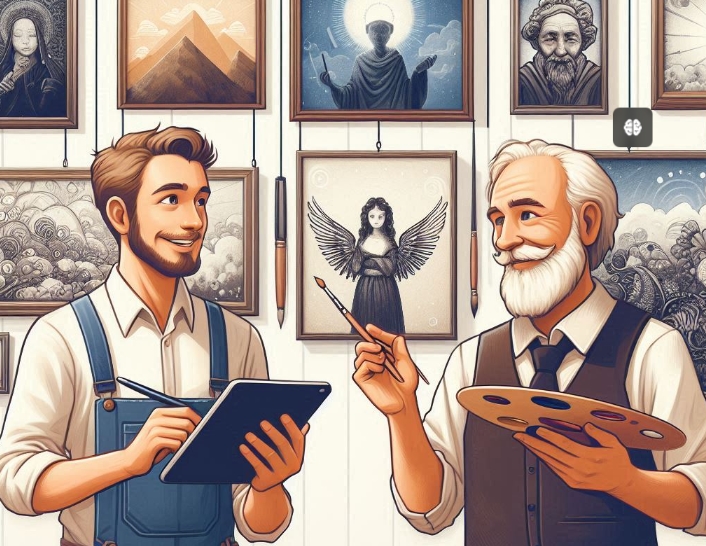
Art, as a timeless form of human expression, has evolved through centuries, continually adapting to technological advancements and cultural shifts. Here’s a philosophical exploration of art’s evolution from traditional to digital mediums:
Traditional Art: Craftsmanship and Cultural Legacy
- Craftsmanship and Tangibility: Traditional art, encompassing paintings, sculptures, and mixed media, emphasizes craftsmanship, tangible forms, and historical narratives. It embodies cultural heritage and human skill passed down through generations.
- Emotional and Sensory Experience: Traditional artworks evoke emotions and provoke thought through tactile textures, vivid colors, and immersive storytelling. They forge intimate connections between artists, viewers, and cultural contexts.
Digital Art: Innovation and Technological Integration Technological
- Advancements: Digital art leverages technology, including software, algorithms, and virtual reality, to create interactive, dynamic, and multisensory experiences. It challenges traditional boundaries of space, time, and medium.
- Democratization of Creativity: Digital platforms democratize artistic production and consumption, enabling global collaboration, instant sharing, and diverse forms of expression. They amplify voices traditionally marginalized in art institutions.
Philosophical Perspectives: Continuity and Transformation
- Continuity in Change: The evolution of art reflects a continuum of creativity, where traditions intersect with innovations to redefine artistic practices and perceptions. Each era builds upon past achievements while embracing new possibilities.
- Adaptation and Resilience: Artists navigate evolving landscapes by adapting traditional techniques to digital mediums or blending analog and digital approaches. They innovate, challenge conventions, and provoke discourse on art’s purpose and relevance.
Embracing Diversity in Artistic Expression
The evolution of art from traditional to digital mediums signifies a broader philosophical journey of adaptation, innovation, and cultural transformation. As technologies evolve and societal values shift, art continues to provoke questions, inspire dialogue, and reflect human experiences across time and space.
Embracing diversity in artistic expression—from traditional craftsmanship to digital innovation—celebrates the richness of human creativity and the enduring quest for meaning, beauty, and truth in the ever-changing landscape of art.
american-boffin.com
bfbchamp.com
democraticcoma.com
tigrepelvar.com
charpoles.com
derbywheelblazers.com
fansfocus.net
guildnow.com
hediyeteyze.com
isprimecdn.com
kiira-korpi.net
manutd24.com
mediumtylerhenry.com
mishanghai.org
savethreestrikes.com
smilesbydavis.com
10puntos.net
band-shirt.com
icelandtrails.com
paulmarioday.com
thefunnynanny.com
Dave Tries Ballet
Buon Grande
Criacao Sites
Perry Perkins Books
Writing Essay in AU
Ka Soku
Blood is Blood Movie
Eleanor Writes Things
The Happy Prince Beirut
Town of Witless Bay
Online Igrovoi Club
Trigeminal Neuralgia - Ronald Brisman MD
Chocolate City Burlesque
Advanced Electric Scooters
W Tougei
Breadboard Maniac
Takasu App



